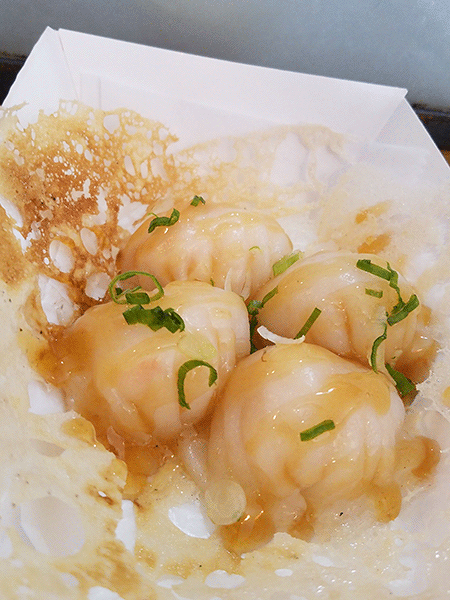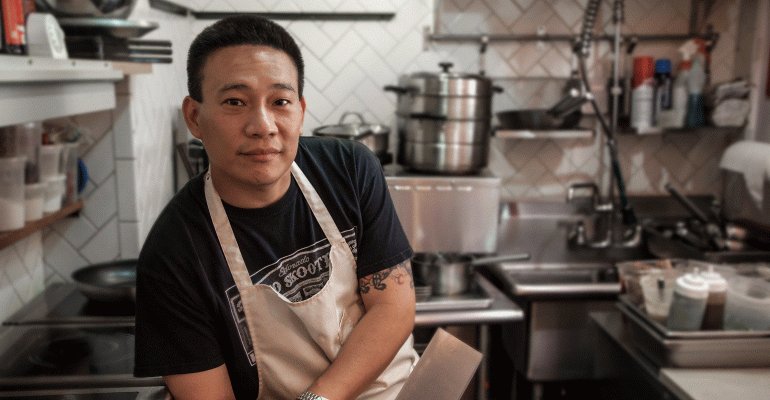These days chefs are thought of as creative people, inventing new dishes and innovating old ones. But for years they were artisans, crafting the same foods faithfully meal after meal, year after year, as their mentors and tradition demanded.
In France, that began to change around 50 years ago with the innovations of Paul Bocuse and his friends in Lyon, who created Nouvelle Cuisine, and in doing so freed chefs from the shackles of Escoffier, who had codified the traditional French cuisine in the early 20th century. The classic dishes still exist, of course, but the role of the chef changed forever.
In the West, at least.
Chinese cuisine has a different, and considerably older, path, and even in 2018 certain dishes aren’t meant to be messed with.
That’s why Chris Cheung’s Cantonese friends and family were skeptical when he presented them with a new version of the har gow dumpling.
“I’d get the look,” Cheung said. “You’re changing the har gow? How you gonna do anything different to a har gow? You can’t. It would be like putting pineapple on pizza to a New York old-school guy.”

Cheung is 100-percent Chinese. His ancestors came from the Cantonese city of Toisan, which you can’t find on a map because it’s labeled with its Mandarin name, Taishan. But to speak with him, you’d think his name would more likely be something like Tony Manero.
He came by his rich Brooklyn accent honestly. He grew up in Bensonhurst, the same neighborhood where the 1970s classic disco film “Saturday Night Fever” takes place.
“I was a little too young to be in the dance clubs,” he said. “We were one of the few Chinese families that settled there. It was mostly you were either Italian, Irish or Jewish.”
Since then, a lot more Chinese, and Russian, families have moved in, he said, but an Italian core remains.
Cheung spent his summers in Manhattan’s Chinatown, where his mother worked in a factory and they lived with his grandmother on Mott Street over a tea house.
 They’d send him downstairs as a 4-year old to pick up food, including har gow.
They’d send him downstairs as a 4-year old to pick up food, including har gow.
“I didn’t know what they were at the time, but I still remember them,” he said. “And I still can get that essence of the feeling of how good they were.”
The har gow is regarded as one of Cantonese cuisine’s greatest dumplings. Along with beggars-purse-shaped shumai and fluffy char siu bao, it’s one of the three dumplings by which dim sum is judged, Cheung said.
Although many dumplings are made at home during family celebrations, most home cooks don’t bother with the har gow, because it’s devilishly hard to make.
The skin is made from a temperamental dough, mostly of tapioca starch and wheat starch, but not wheat protein. So it’s gummy, tacky, inelastic and difficult to work with.
“It’s traditionally made by having that dough put in a circle,” Cheung said. “Then you have a special cleaver that you slam on the table and spread the skin out.”
Without the elasticity of gluten, “It’s not something that you’re going to be able to shape around,” Cheung said. “Wiggle room? No. You have to get the filling amount to the size of the skin just right and then fold it.”
Har gow are always stuffed with shrimp. In fact, “har” means “shrimp” and “gow” means “dumpling,” so you don’t really have a choice. The shrimp has to be chopped in a particular way, so that when it’s wrapped in the dumpling skin and steamed it has “a coarse but very tight, meaty texture, wrapped with this dough that’s unlike any other dough for dumplings,” Cheung said.
The dumpling’s skin is gummy, and though it’s not quite slimy, it almost feels like it wants to be slimy. It’s a texture that’s alien to most Westerners, but highly prized in much of East Asia.
Cheung didn’t start out as a Chinese cook. He attended the New York Restaurant School, graduated with honors and started working for legendary Asian-fusion chef Jean-Georges Vongerichten at Vong, a fine-dining Thai-French restaurant in Midtown Manhattan. He was an opening cook at modern Japanese restaurant Nobu, working under Masaharu Morimoto, who went on to become one of the original stars of “Iron Chef,” before returning to work for Vongerichten at Jean Georges, working side-by-side with soon-to-be-famous chefs like Wylie Dufresne and Didier Virot.
He then went on to be chef of Ruby Foo’s, a Chinese-fusion restaurant that was part of B.R. Guest Hospitality.
Shortly thereafter, he opened his first restaurant, Tiger Blossom, which had the misfortune to debut in New York’s East Village in the summer of 2001.
September 11 and the economic nosedive that followed put an end to many New York City restaurants, including Cheung’s, who went on to work in assorted other restaurants, including the renowned Monkey Bar, where he introduced the guests to modern Chinese dishes.
During the 2008 economic downturn, he found himself at a restaurant called China 1, where he introduced guests to traditional dumplings as well as creative ones, like a soft foie gras-filled bao bun.
He later made TV appearances on shows including The Food Network’s “Next Great Chef” and Ilan Hall’s Esquire TV show “Knife Fight.” He also was on the Travel Channel’s “No Reservations” as Anthony Bourdain’s guide through the Chinatown where he spent his summers.
In 2015, Cheung opened East Wind Snack Shop in the Brooklyn neighborhood of Windsor Terrace, not too far from Bensonhurst, to wide acclaim, and has since opened a second location in the nearby neighborhood of Williamsburg.
He also helped Maneet Chauhan open Tansuo in Nashville, although he said he’s no longer involved in day-to-day operations there.
East Wind has pork, beef and vegetable dumplings, but Cheung needed something else to round out the menu. “I wanted a seafood dumpling, and of course when I thought about that, the natural thing was to turn to making a har gow,” he said.
With a small menu and tiny kitchen, he’d have to make a lot of them in tight quarters. “But we pulled up our sleeves and adhered to the discipline of making them,” he said.
Still, he wondered, “Even though it was my favorite dumpling, I always felt, could there be something missing here? As a chef, coming from my brain, can we give this a new look?”
His natural instinct was to try pan-frying them, for the simple reason that pan-fried dumplings are delicious. He said it was good, but he wanted something more.
Traditionally har gow are served in little steamer trays, their bottoms stuck to the thin paper lining each tray. Cheung decided that instead of having them stick to paper, he could get them to stick to a thin, crispy tapioca crust of sorts.
It took several months of searing the har gow briefly before adding a tapioca slurry, then some water, covering it, steaming it to cook the dumplings, then letting the water evaporate, then adding a little more starch and oil to create a lattice-work resting place for the dumplings.
The result is the same gummy, delicious dumplings of Cheung’s childhood, with a bit of added crunch, plus some abalone sauce that reminds him of the dried squid he ate in Chinatown’s movie theaters as a kid.
Cheung said his Cantonese friends and family still won’t necessarily admit that they like them. “But they’ll finish their plates.”
Contact Bret Thorn at [email protected]
Follow him on Twitter: @foodwriterdiary





